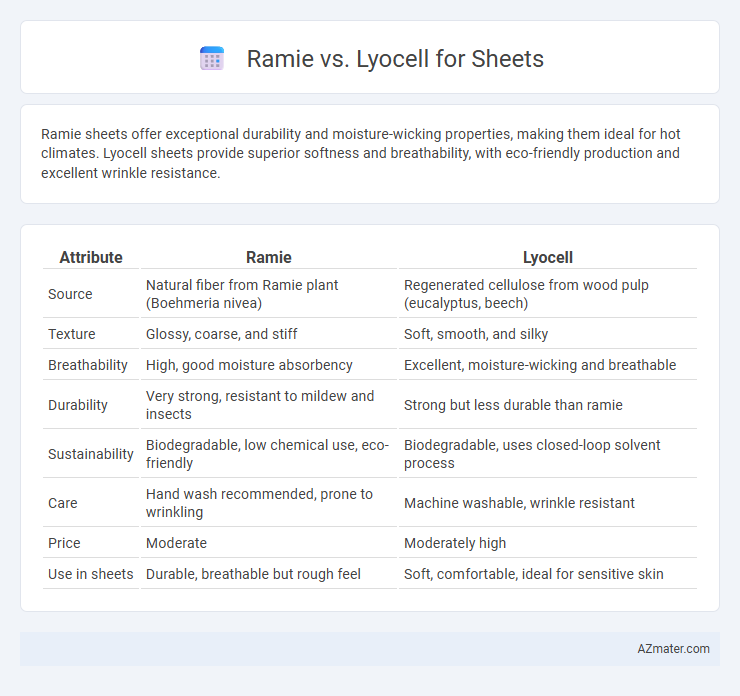Ramie sheets offer exceptional durability and moisture-wicking properties, making them ideal for hot climates. Lyocell sheets provide superior softness and breathability, with eco-friendly production and excellent wrinkle resistance.
Table of Comparison
| Attribute | Ramie | Lyocell |
|---|---|---|
| Source | Natural fiber from Ramie plant (Boehmeria nivea) | Regenerated cellulose from wood pulp (eucalyptus, beech) |
| Texture | Glossy, coarse, and stiff | Soft, smooth, and silky |
| Breathability | High, good moisture absorbency | Excellent, moisture-wicking and breathable |
| Durability | Very strong, resistant to mildew and insects | Strong but less durable than ramie |
| Sustainability | Biodegradable, low chemical use, eco-friendly | Biodegradable, uses closed-loop solvent process |
| Care | Hand wash recommended, prone to wrinkling | Machine washable, wrinkle resistant |
| Price | Moderate | Moderately high |
| Use in sheets | Durable, breathable but rough feel | Soft, comfortable, ideal for sensitive skin |
Introduction to Ramie and Lyocell
Ramie is a natural fiber derived from the stalks of the Chinese nettle plant, known for its durability, moisture-wicking properties, and silk-like luster, making it a premium choice for breathable, long-lasting sheets. Lyocell, a semi-synthetic fiber made from sustainably sourced wood pulp using an eco-friendly solvent spinning process, offers exceptional softness, breathability, and moisture absorption, ideal for comfortable and hypoallergenic bedding. Both fibers provide sustainable alternatives to traditional cotton, with Ramie excelling in strength and texture, and Lyocell in softness and environmental impact.
Ramie: Origins and Properties
Ramie, derived from the stalks of the Chinese nettle plant (Boehmeria nivea), is a natural bast fiber prized for its exceptional strength and durability, making it ideal for bedding such as sheets. It boasts high absorbency, resistance to bacteria, and a silky luster, offering breathability and comfort similar to linen but with greater resistance to wrinkling. Compared to Lyocell, a regenerated cellulose fiber made from sustainably sourced wood pulp, Ramie provides superior tensile strength and moisture-wicking capabilities, making it a resilient and eco-friendly option for high-quality bed linens.
Lyocell: Origins and Properties
Lyocell, derived from sustainably sourced wood pulp, is a biodegradable fabric known for its exceptional softness, breathability, and moisture-wicking properties, making it ideal for bed sheets. Its closed-loop production process minimizes environmental impact, contrasting with Ramie, which is a natural fiber obtained from the stalks of the ramie plant and often less absorbent and less soft. Lyocell sheets regulate temperature effectively, offer durability, and resist wrinkles, enhancing comfort and longevity in bedding applications.
Texture and Feel: Ramie vs Lyocell
Ramie sheets offer a coarse, textured feel that becomes softer with use, providing a natural, breathable fabric ideal for hot climates. Lyocell sheets have a smooth, silky texture, known for their exceptional softness and moisture-wicking properties, making them gentle against sensitive skin. Both fibers excel in breathability, but Lyocell tends to feel cooler and more luxurious compared to the slightly rougher, sturdy texture of Ramie.
Durability and Longevity Comparison
Ramie fibers exhibit exceptional durability due to their high tensile strength and resistance to wear, making ramie sheets highly durable over prolonged use. Lyocell sheets offer moderate durability, benefiting from their smooth surface and resistance to pilling but tend to be less resistant to abrasion compared to ramie. The longevity of ramie sheets surpasses lyocell, as ramie maintains structural integrity and texture despite frequent washing, whereas lyocell may degrade faster under heavy usage conditions.
Breathability and Moisture Management
Ramie sheets offer excellent breathability due to their natural cellulose fiber structure, allowing air to flow freely and keeping sleepers cool. Lyocell fabric excels in moisture management by efficiently wicking away sweat and drying quickly, reducing discomfort caused by humidity. Both fibers provide superior comfort, but ramie is preferred for enhanced airflow, while lyocell is ideal for optimal moisture absorption and quick-drying properties.
Environmental Impact: Sustainability of Ramie and Lyocell
Ramie fibers are derived from the stalks of the Boehmeria plant, requiring minimal pesticides and water, making them a highly sustainable option for eco-friendly sheets. Lyocell is produced through a closed-loop process that recycles solvents, significantly reducing environmental pollutants and ensuring responsible use of natural resources. Both Ramie and Lyocell offer low-impact alternatives to conventional cotton, with Ramie excelling in biodegradability and Lyocell leading in renewable manufacturing practices.
Allergenicity and Skin Sensitivity
Ramie fabric is naturally hypoallergenic and resistant to bacteria and mold, making it an excellent choice for individuals with sensitive skin or allergies. Lyocell sheets, derived from sustainably sourced wood pulp, are also hypoallergenic and highly breathable, reducing the risk of irritation and promoting moisture-wicking properties. Both materials offer comfort for sensitive skin, but ramie's stronger natural antimicrobial qualities may provide superior protection against allergens.
Care and Maintenance Requirements
Ramie sheets demand gentle washing with mild detergent in cold water to preserve their natural luster and prevent fiber weakening, while avoiding bleach and high heat during drying to reduce shrinkage. Lyocell sheets are more resilient, requiring machine wash in warm water with a gentle cycle and can be tumble dried on low heat, making them easier to maintain. Both materials benefit from air drying and ironing on low settings to prolong fabric life and maintain smoothness.
Which Is Better for Sheets: Ramie or Lyocell?
Ramie and Lyocell both offer unique benefits for sheets, but Lyocell is generally better due to its superior softness, moisture-wicking properties, and durability, making it ideal for comfortable, breathable bedding. Ramie, a natural fiber derived from nettle plants, is highly durable and resistant to wrinkles but tends to be rougher and less moisture-absorbent compared to Lyocell. For those seeking smooth, eco-friendly sheets with excellent temperature regulation, Lyocell is the preferable choice over Ramie.

Infographic: Ramie vs Lyocell for Sheet
 azmater.com
azmater.com